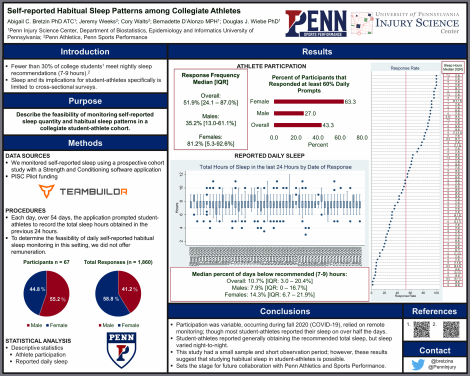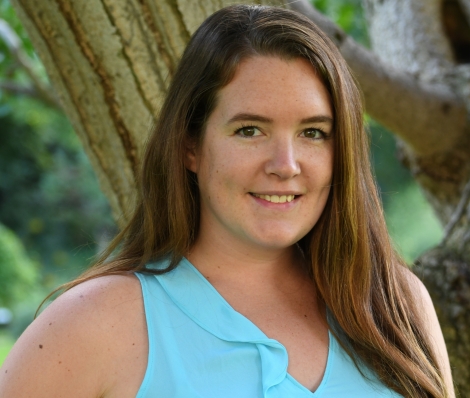Abby Bretzin
Self-reported Habitual Sleep Patterns among Collegiate Athletes
Abstract
Background: Fewer than 30% of college students meet nightly sleep recommendations (7-9 hours). Sleep and its implications for student-athletes specifically is limited to cross-sectional surveys.
Objective: Describe the feasibility of monitoring self-reported sleep quantity and habitual sleep patterns in a collegiate student-athlete cohort.
Methods: We monitored self-reported sleep using a prospective cohort study with a daily performance tracking application (TEAMBUILDR). Each day, over 54 days, the application prompted student-athletes to record the total sleep hours obtained in the previous 24 hours. To determine the feasibility of daily self-reported habitual sleep monitoring in this setting, we did not offer remuneration.
Results: Sixty-seven student-athletes on x sports teams (male: 55.2%, n=37) provided 1,860 responses (male: 41.2%, n=767). Response frequency ranged from 1-54 days, with a median of responding on 53.8% (interquartile range[IQR]: 24.5-88.7) of days. Males’ median days responding was 35.8% (IQR: 13.2-62.3%); females’ was 81.9% (IQR: 55.3-94.4). Overall, 43.3% of student-athletes responded on at least 60% of days. The daily sleep in this cohort overall was 7.6±1.1 hours on average; males=7.7±1.1, females=7.5±1.1 hours daily. Approximately 15.1% (n=280/1,860) of reported sleep was shorter than the recommended hours. Collapsed within individuals, each student-athletes’ the median hours of sleep ranged from 6-9.5 hours/day.
Conclusions: Participation was variable, though most student-athletes reported their sleep on over half the days. Student-athletes reported generally obtaining the recommended total sleep, but sleep varied night-to-night. This study had a small sample and short observation period; however, these results suggest that studying habitual sleep in student-athletes is possible.
Keywords
sleep, athlete, sleep hygieneCommenting is now closed.
About Us
To understand health and disease today, we need new thinking and novel science —the kind we create when multiple disciplines work together from the ground up. That is why this department has put forward a bold vision in population-health science: a single academic home for biostatistics, epidemiology and informatics.
© 2023 Trustees of the University of Pennsylvania. All rights reserved.. | Disclaimer



